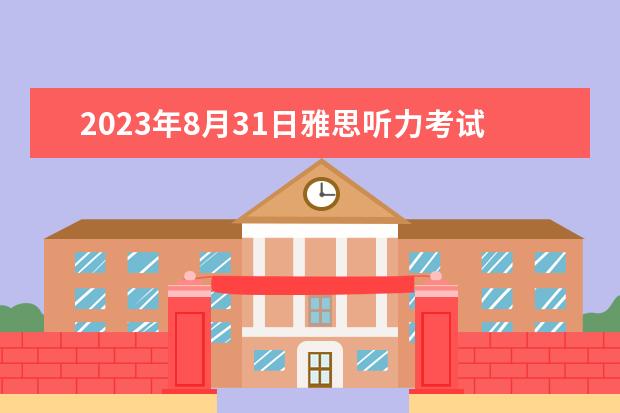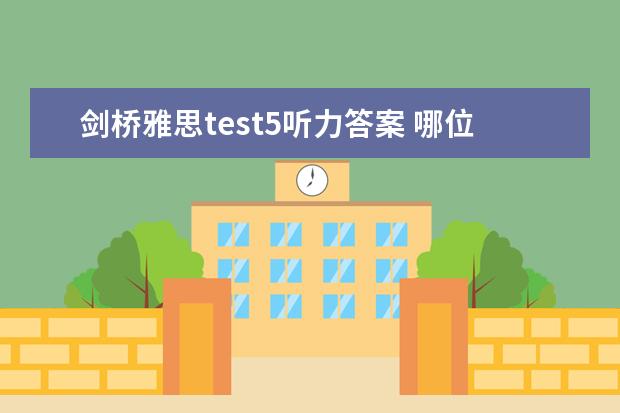很多关注雅思听力的朋友很希望了解雅思听力剑桥5原题和答案 哪位有雅思剑5test1passage2的原文和答案?谢谢,今天雅思无忧为大家整理了相关文章,一起来看看吧!

哪位有雅思剑5test1passage2的原文和答案?谢谢
Nature or Nurture?
A) A few years ago. in one of the most fascinating and disturbing experiments in behavioral psychology. Stanley Milgram of Yale University tested 40 subjects from all walks of life for their willingness to obey instructions given by a 'leader' in a situation in which the subjects might feel a personal distaste for the actions they were called upon to perform. Specifically, Milgram told each volunteer 'teacher-subject' that the experiment was in the noble cause of education, and was designed to test whether or not punishing pupils for their mistakes would have a positive effect on the pupils' ability to learn.
B) Milgram's experimental set-up involved placing the teacher-subject before a panel of thirty switches with labels ranging from '15 volts of electricity (slight shock)' to '450 volts (danger - severe shock)' in steps of 15 volts each. The teacher-subject was told that whenever the pupil gave the wrong answer to a question, a shock was to be administered, beginning at the lowest level and increasing in severity with each successive wrong answer. The supposed 'pupil' was in reality an actor hired by Milgram to simulate receiving the shocks by emitting a spectrum of groans, screams and writhing together with an assortment of statements and expletives denouncing both the experiment and the experimenter. Milgram told the teacher-subject to ignore the reactions of the pupil, and to administer whatever level of shock was called for. as per the rule governing the experimental situation of the moment.
C) As the experiment unfolded, the pupil would deliberately give the wrong answers to questions posed by the teacher, thereby bringing on various electrical punishments, even up to the danger level of 300 volts and beyond. Many of the teacher-subjects balked at administering The higher levels of punishment, and turned to Milgram with questioning looks and/or complaints about continuing the experiment. In these situations, Milgram calmly explained that the teacher-subject was to ignore the pupil's cries for mercy and carry on with the experiment. If the subject was still reluctant to proceed, Milgram said that it was important for the sake of the experiment that the procedure be followed through to the end His final argument was, 'You have no other choice. You must go on." What Milgram was trying to discover was the number of teacher-subjects who would be willing to administer the highest levels of shock, even in the face of strong personal and moral revulsion against the rules and conditions of the experiment.
D) Prior to carrying out the experiment, Milgram explained his idea to a group of 39 psychiatrists and asked them to predict the average percentage of people in an ordinary population who would be willing to administer the highest shock level of 450 volts. The overwhelming consensus was that virtually all the teacher-subjects would refuse to obey the experimenter. The psychiatrists felt that 'most subjects would not go beyond 150 volts' and they further anticipated that only four per cent would go up to 300 volts. Furthermore, they thought that only a lunatic fringe of about one in 1.000 would give the highest shock of 450 volts.
E) What were the actual results? Well, over 60 per cent of the teacher-subjects continued to obey Milgram up to the 450-volt limit! In repetitions of the experiment in other countries, the percentage of obedient teacher-subjects was even higher, reaching 85 per cent in one country. How can we possibly account for this vast discrepancy between what calm, rational, knowledgeable people predict in the comfort of their study and what pressured, flustered, but cooperative teachers' actually do in the laboratory of real life?
F) One's first inclination might be to argue that there must be some sort of built-in animal aggression instinct that was activated by the experiment, and that Milgram's teacher-subjects were just following a genetic need to discharge this pent-up primal urge onto the pupil by administering the electrical shock. A modern hard-core sociobiologist might even go so far as to claim that this aggressive instinct evolved as an advantageous trait, having been of survival value to our ancestors in their struggle against the hardships of life on the plains and in the caves, ultimately finding its way into our genetic make-up as a remnant of our ancient animal ways.
G) An alternative to this notion of genetic programming is to see the teacher-subjects' actions as a result of the social environment under which the experiment was carried out. As Milgram himself pointed out. Most subjects in the experiment see their behaviour in a larger context that is benevolent and useful to society - the pursuit of scientific truth. The psychological laboratory has a strong claim to legitimacy and evokes trust and confidence in those who perform there. An action such as shocking a victim, which in isolation appears evil, acquires a completely different meaning when placed in this setting."
H) Thus, in this explanation the subject merges his unique personality and personal and moral code with that of larger institutional structures, surrendering individual properties like loyalty, self-sacrifice and discipline to the service of malevolent systems of authority.
I) Here we have two radically different explanations for why so many teacher-subjects were willing to forgo their sense of personal responsibility for the sake of an institutional authority figure. The problem for biologists, psychologists and anthropologists is to sort out which of these two polar explanations is more plausible. This, in essence, is the problem of modern sociobiology - to discover the degree to which hard-wired genetic programming dictates, or at least strongly biases, the interaction of animals and humans with their environment, that is, their behaviour. Put another way, sociobiology is concerned with elucidating the biological basis of all behaviour.
答案:
14. F
15. A
16. B
17. D
18. I
19. C
20. B
21. D
22. C
23. Not Given
24. True
25. False
26. False
2023年5月11日雅思听力考试真题及答案
您好,我是专注留学考试规划和留学咨询的小钟老师。在追寻留学梦想的路上,选择合适的学校和专业,准备相关考试,都可能让人感到迷茫和困扰。作为一名有经验的留学顾问,我在此为您提供全方位的专业咨询和指导。欢迎随时提问!
上周的雅思考试已经圆满结束,真题及答案也新鲜出炉。下面来跟着小钟老师看一看2023年5月11日雅思听力考试真题及答案。
场景话题:
S1电影俱乐部介绍/ S2澳洲新建度假中心/ S3广告/ S4人类模仿生物进行仿生设计
题型设置:
S1填空(新题)/ S2单选+多选(旧题)/ S3单选+配对(新题)/ S4填空(旧题)
12
解析:
本次考试场景为两新两旧,选择与填空题比例为20:20,难度适中。
填空题具体答案如下:(仅供参考)
s1rook;学生3. 22;4. 89460733;停车;历史;7.软件;传记恐怖10.青少年
S2les;12.有个别池塘;13.马牧场;14.?;15.适合所有年龄段;16.星期四和星期五;17.旅游商店;18.旅游预订处;19.认识艺术家;20.了解药物
s3e publications-B;ls-d;23.一般兴趣杂志-G;ites-A;mas-F;26.交易会 - G.
s4:31。狩猎;32.钢铁;头发;34.钓鱼;体育;痛苦;37.噪音;38.董事会;39.隧道;40.能量
点评:本场考试题型仍然比较常规化:单选,配对,多选,填空整场考试难度适中,场景为两旧两新,没有出现太难的生词拼写,不过细节方面还是需要注意,比如单复数形式,听力过程中一定要放平心态,集中注意力。其中S3难度偏大,语速偏快,整体反应配对部分偏难。建议学生在接下来的备考中,一定多提高听力基本功,提高语速,同时注意对配对题的针对性练习。
参考剑桥练习:剑10Test1S4,剑8Test4Section2,剑8Test3S4等
备注:在接下来的备考中,选择题(尤其是单选和配对)仍然是重中之重,同时加强多留意多选题的练习考生们可以选取剑桥真题的类似组合着重训练,记得多总结以及同义替换的积累。在练习听力的过程中,由于S3的难度有所提升,注意适当提高语速,平时练习时可加至1.25-1.5倍速练习。
考试预测
1.场景方面:场景方面依旧是主流场景(咨询,旅游,课程讨论,讲座),在接下来的考试中,考生还应将重点放在S1求职,租房,S2旅游,活动及公共场所设施介绍,S3课程讨论及论文写作,S4动植物,环境,历史,学术等各类学术讲座,同时下场考试应着重准备地图题等配对练习。
2.机经:如需参考机经,以2023 - 2023年机经为主。
希望以上的答复能对您的留学申请有所帮助。如果您有任何更详细的问题或需要进一步的协助,我强烈推荐您访问我们的留学官方网站
,在那里您可以找到更多专业的留学考试规划和留学资料以及*的咨询服务。祝您留学申请顺利!
2023年6月5日雅思考试听力部分答案
您好,我是专注留学考试规划和留学咨询的小钟老师。在追寻留学梦想的路上,选择合适的学校和专业,准备相关考试,都可能让人感到迷茫和困扰。作为一名有经验的留学顾问,我在此为您提供全方位的专业咨询和指导。欢迎随时提问!
在各种英语类的考试中,雅思是很多出国留学的学生选择的一项考试,雅思的听力部分有很多同学不了解,大家可以看看6月5日雅思考试真题,下面是小钟老师带来的真题答案。
一、2023年6月5日雅思考试听力部分答案
Part 1 poppy garden罂粟花园咨询
题型:填空
1. The poppies will be at their best at the end of the month
2. The poppies on the hills are orange in color
3. The reserve is located to the east of the garden
4. The best time for photography is mid-afternoon
另一版本为:this park is a state park
5. Wear trousers because of rattlesnakes
6. general tour
7. viewpoint of center
8. 1 hour
9. 5.30 am to 1.00 pm
10. to bring the tripods and zoom lens of camera
Part 2 从机场到宾馆交通住宿介绍
题型:选择+地图
11-14 选择
11. what did the message say about the shuttle bus
B. it takes a longer time
12. what does the message say about the bus
C. bus has no convenient stop
13. how to go to the hotel after arrival?
B. get off at the third stop by taking subway
14. what did T tell Jane about the ticket?
A. she needs to keep the ticket in the journey
15-20 地图
15. Linkin Avenue: A (河旁边)
16. 中间的道路:B
17. taxi pick up point: E (入口对面)
18. bus stop: I (最右边)
19. café: D (宾馆旁边)
20. Restaurant: G (宾馆对面街中间)
Part 3 家谱研究
题型:选择+匹配
21-26 选择
21. how they will collect useful material for family histories?
B. read relevant materials
22. what are the main subjects they interview
C. both males and females
23. which methodology used by the girl she felt the most interesting
C. interviewing old participants
24. how can the female students trace her family information
A. by contacting one relative living abroad
25. what is the suggestion of the tutor?
C. she concerned too much about her own family information
26. why did the girl worry about her topic
B. her research may be too simplified
27-30 匹配
27. references to family histories: E. varied
28. introduction: A. clear
29. methodology: C. detailed
30. conclusion: B. memorable
Part 4 红海海胆
题型:填空
31-40 填空
31. feed on plants
32. covered in spines that protect it
33. regarded as pest
34. Asia was an important market
35. scientific interest: because of the decline in urchin population
36. when it dies, no evidence of aging
37. maximum of life span: 200 years old
38. after 22 years old, grow 0.1 cm per year
39. can still breed and grow
40. the growth is unconnected to ocean conditions
二、雅思听力提高方法
素材选择
针对雅思听力练习的素材比较挑剔,因为考试时音频播放的语音以英音为主,因此考生课后自行练习的素材也必须顺应此趋势。那么最理想的除了剑桥系列以外,还首推BBC系列纪录片,比如大家耳熟能详的《地球脉动》,或者适当的英剧。让听觉长期浸泡在英音的海洋中,对其敏感性以及反映速度也会随之提升。
连贯性
任何语言的习得,技能的掌握,本领的练就无不遵循此原则。所谓熟能生巧,熟练的前提就是建立在连贯性基础之上的。针对听力练习来说,如果考试日期在百天以内,那么以每周练习3~5次,间隔开来,每次练习时间不少于1小时为合格。如果考试时间不确定的话,也要保证每周至少听三次的频率,一周听一次,等于没听。
精听还是泛听?
所谓精听,即逐词逐句反映听力中的内容,反映就是将英文在脑海中转化成对应的中文加以理解。反映的速度快,理解的就快,答题准确率就高,听力能力就强,反之亦然。
因此,精听在听力练习中是最关键的部分。在每天的1小时听力练习时间中,至少有半个小时是来进行精听的,将听到的内容细致的反映出来,如果听3遍还没有概念,迅速看文本,查明究竟是因为生词,自身发音与其不一致,还是语音现象等原因来进行重点标记及消化,并周期性复习。
泛听旨在让听觉熟悉语音环境,培养语感,适用备考时间充沛的学生。但是泛听的忌讳是音频过耳不过脑。
理想的练习方法是精听与泛听的结合。精听听细节,泛听听大意。
三、雅思听力做题顺序
学会预测答案
看卷子的时候,有经验的考生会发现很多题目能快速预测答案,考生可以在试卷上做好笔记,如答案的词性,对话大纲,关键信息词等,猜测愈准,分数愈高。甚至在对话的时候能试猜测会有多少人说话,他们会做什么,说什么和会用什么词。
当然预测答案这个技巧也是建立在平时听力练习的次数上,听力考试中有很多套了,比如话题的转折,举例等等,这时候听到关键信号词,考生们很快就能发现听力答案。
听写重要性
关于听写有几个技巧:
1. 关注所划的关键词,弄清题目的意思,知道应留意什么答案。
2. 用速记方法记录有用资料或填写答案(shorthand)。
3. 随时预备答题,进入高度戒备状态。
4. 留意答案可能会在答案纸上找到。
5. 雅思出题原则大总结。
顺序原则:雅思听力答案是根据顺序出现的,有时答案会在很早的时候,甚至是第1句就出现,有时2个答案会在短时间内接连说出。
修正原则:说话人有时会改变主意,听到停顿,but,语气犹豫的地方,要当心,很可能是答案。
最后原则:不要轻易写答案,等听完整句后再填写,答案一般在最后出现,听到最后再确认。
重复原则:重复和强调的地方一般就是答案。
重读原则:听力的语境里对话的人是有情绪的,注意语音重读的是答案。
问答原则:在对话中,有问必有答,问答为答案。
填写答案
雅思考试最后10分钟是拿来填写答案和检查的,这个时间一定要把握好。
检查,检查,检查!
重要的事情说三遍,听力答案填写完一定要看是否有拼写错误,填写顺序错误,漏填这些问题,顺便把空着的地方都补上答案。检查是为了避免不必要的失分,时间紧任务重,考生们也千万重视。
希望以上的答复能对您的留学申请有所帮助。如果您有任何更详细的问题或需要进一步的协助,我强烈推荐您访问我们的留学官方网站
,在那里您可以找到更多专业的留学考试规划和留学资料以及*的咨询服务。祝您留学申请顺利!
以上就是雅思无忧为大家带来的雅思听力剑桥5原题和答案 哪位有雅思剑5test1passage2的原文和答案?谢谢,希望能帮助到大家,更多相关信息,敬请关注雅思无忧!
雅思培训
免责声明:文章内容来自网络,如有侵权请及时联系删除。


 剑桥5雅思听力原文 哪位有雅思剑5test1passage2的原文和答案?谢谢
剑桥5雅思听力原文 哪位有雅思剑5test1passage2的原文和答案?谢谢
 剑桥雅思听力5test答案 哪位有雅思剑5test1passage2的原文和答案?谢谢
剑桥雅思听力5test答案 哪位有雅思剑5test1passage2的原文和答案?谢谢
 2023年8月31日雅思听力考试真题及答案 哪位有雅思剑5test1passage2的原文和答案?谢谢 剑桥雅思5 TEST 1 SECTION 3 的答案问题
2023年8月31日雅思听力考试真题及答案 哪位有雅思剑5test1passage2的原文和答案?谢谢 剑桥雅思5 TEST 1 SECTION 3 的答案问题
 5月15日雅思听力考试参考答案 哪位有雅思剑5test1passage2的原文和答案?谢谢 2023年5月11日雅思听力考试真题及答案
5月15日雅思听力考试参考答案 哪位有雅思剑5test1passage2的原文和答案?谢谢 2023年5月11日雅思听力考试真题及答案
 剑桥雅思5的听力原文 哪位有雅思剑5test1passage2的原文和答案?谢谢
剑桥雅思5的听力原文 哪位有雅思剑5test1passage2的原文和答案?谢谢
 剑桥雅思test5听力答案 哪位有雅思剑5test1passage2的原文和答案?谢谢
剑桥雅思test5听力答案 哪位有雅思剑5test1passage2的原文和答案?谢谢
 哪位有雅思剑5test1passage2的原文和答案?谢谢(剑桥雅思5 TEST 1 SECTION 3 的答案问题)
哪位有雅思剑5test1passage2的原文和答案?谢谢(剑桥雅思5 TEST 1 SECTION 3 的答案问题)
 哪位有雅思剑5test1passage2的原文和答案?谢谢(剑桥雅思阅读长难句分析85)
哪位有雅思剑5test1passage2的原文和答案?谢谢(剑桥雅思阅读长难句分析85)
 雅思剑桥阅读5test1passage2 请问2023年3月2日雅思阅读考试真题及答案
雅思剑桥阅读5test1passage2 请问2023年3月2日雅思阅读考试真题及答案
 剑桥雅思阅读test1 p2 哪位有雅思剑5test1passage2的原文和答案?谢谢
剑桥雅思阅读test1 p2 哪位有雅思剑5test1passage2的原文和答案?谢谢